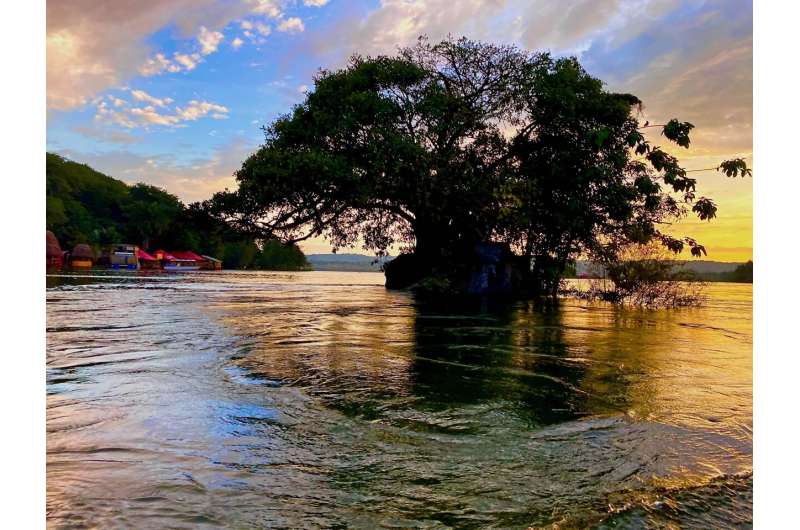This article has been reviewed according to Science X's editorial process and policies. Editors have highlighted the following attributes while ensuring the content's credibility:
fact-checked
peer-reviewed publication
trusted source
proofread
Death tolls from climate disasters will 'balloon' without investment in Africa's weather stations, experts warn

The climate crisis is increasing the frequency and intensity of floods, droughts and heat waves, with Africa expected to be among the global regions hit hardest.
Yet the systems and technologies across the continent that monitor and forecast weather events and changes to water levels are "missing, outmoded or malfunctioning"—leaving African populations even more exposed to climate change.
This is according to a team of risk experts and climatologists from the UK and Africa led by the University of Cambridge, who warn that without major and rapid upgrades to "hydromet infrastructure," the damage and death toll caused by climate-related disasters across Africa will "balloon."
Writing in the journal Nature, the authors point to latest research showing that—over the last two decades—the average number of deaths caused by a flooding event in Africa is four times higher than the European and North American average per flood.
When investigating this disparity, the team looked at World Meteorological Organization (WMO) data and found the entire continent of Africa has just 6% of the number of radar stations as the US and Europe's combined total, despite having a comparable population size and a third more land.
Radar stations detect weather fluctuations and rainfall as well as long-term climate trends, and are vital for the forewarning of impending floods and other meteorological events. The African continent has just 37 such stations.
Moreover, WMO data shows that more than 50% of the radar stations that do currently operate across Africa are unable to produce accurate enough data to predict weather patterns for the coming days or even hours.
The research team call on the international community to boost funding for systems that mitigate risks to life from climate disasters. Currently, just US $0.47 of every $100 spent on global development aid goes towards disaster risk reduction of any kind.
"The vast gaps in Africa's disaster reduction systems are in danger of rendering other aid investments redundant," said Dr. Asaf Tzachor, co-lead author and research affiliate at Cambridge's Center for the Study of Existential Risk (CSER). "For example, there is little point investing in smallholder farms if floods are simply going to wash away seeds, agrochemicals, and machinery."
"We need to offer all Africans a chance to reduce their exposure to climate risks by fixing this glaring hydro-meteorological blind spot, before ever more lives are lost to the effects of global heating."
To illustrate their point, the team compare two recent category 4 storms: Tropical Cyclone Idai hit southeast Africa in 2019, and Hurricane Ida swept the eastern US in 2021. Both had wind speeds of over 200km/hour.
US populations received evacuation alerts before Ida hit land, but the limited 'hydromet' capabilities meant Idai caught African nations by surprise. The US death toll was under 100, while over 1,000 Africans lost their lives.
"Multilayered hydromet systems, including weather monitoring, forecasting and early warning, are taken for granted by the Global North, and have been for decades," said co-lead author Dr. Catherine Richards, also from CSER at the University of Cambridge.
"Meanwhile, the most foundational layer on which the others depend is often missing, outmoded or malfunctioning across Africa—more so than any other global region."
"Well-funded hydromet systems must become a priority to help at-risk populations mitigate and adapt to weather-related hazards as the effects of climate change take hold," Richards said.
The team outline a series of recommendations for plugging Africa's weather-warning gap.
Firstly, identify the most at-risk areas. "Types of climate hazard vary wildly across the continent—from the cyclones in Madagascar to the protracted droughts of east Africa," said Tzachor.
"The need for more weather stations across Africa is undeniable, but this must go hand-in-hand with improved satellite monitoring and major training initiatives to increase the number of skilled African meteorologists."
The latest computational techniques must be adopted, say the authors, including automated AI approaches that combine weather data with social media activity to predict disaster dynamics.
Early warning systems need to be expanded, and provide clear directions to evacuate in local dialects. "Over 80% of Africans have access to a mobile network, so text messages could be a powerful way to deliver targeted warnings," said Richards.
Finally, major investment will be vital—and pay dividends. "The World Bank has estimated a $1.5 billion price tag for continent-wide hydromet systems, but it would save African countries from $13 billion in asset losses and $22 billion in livelihood losses annually," said Tzachor. "A nearly nine-to-one return on investment is surely a no-brainer."
In Europe and the US, there are 636 radar stations for a total population of 1.1 billion and a landmass of 20 million km². In Africa, there are just 37 for a comparable population of 1.2 billion and landmass of 30 million km².
More information: Asaf Tzachor et al, How to reduce Africa's undue exposure to climate risks, Nature (2023). DOI: 10.1038/d41586-023-02557-x
Journal information: Nature
Provided by University of Cambridge



















